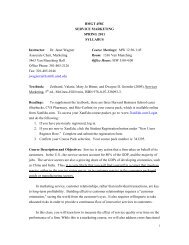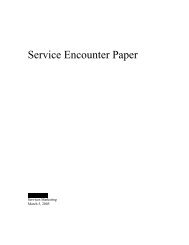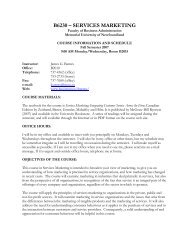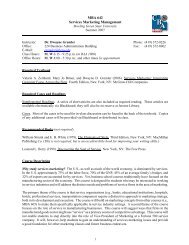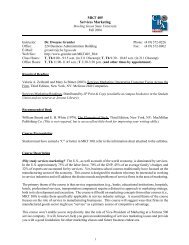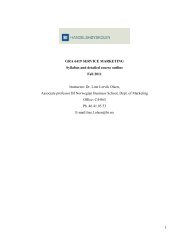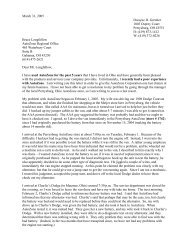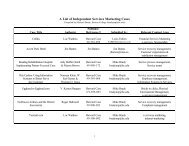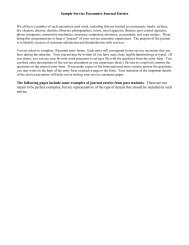Rapport-Building Behaviors Used by Retail Employees - Gremler.net
Rapport-Building Behaviors Used by Retail Employees - Gremler.net
Rapport-Building Behaviors Used by Retail Employees - Gremler.net
You also want an ePaper? Increase the reach of your titles
YUMPU automatically turns print PDFs into web optimized ePapers that Google loves.
D.D. <strong>Gremler</strong>, K.P. Gwinner / Journal of <strong>Retail</strong>ing 84 (3, 2008) 308–324 313ducting further analyses. Therefore, we base our study on 388critical incidents containing 824 rapport-building behaviors.ReliabilityTo assess the reliability of the classification scheme, we usetwo statistics: percentage of agreement and Perreault and Leigh’s(1989) I r statistic. Across the 824 rapport-building behaviors,Judges C and D independently agree about the classificationof 680 behaviors for an overall agreement percentage of .825.Perreault and Leigh’s I r value, which takes into account the numberof categories included in the classification scheme, is .939across the two judges, well above the average of .85 typicallyreported in critical incident research (cf. <strong>Gremler</strong> 2004). Thesestatistics suggest a high level of reliability for our identificationof rapport-building behaviors according to our classificationscheme.ResultsAn analysis of the incidents suggests the rapport-buildingbehaviors used <strong>by</strong> retail employees in interactions with customersare relatively consistent with the a priori behaviorsidentified in previous literature. Overall, we find that retailemployees use five broad categories of rapport-building behaviorsin commercial contexts: uncommonly attentive behavior,common grounding behavior, courteous behavior, connectingbehavior, and information sharing behavior. Three of these fivecategories are consistent with existing rapport literature, whereastwo represent categories of behaviors not frequently mentionedin cultivating rapport. We provide a summary of the results inTable 1, which includes the five major categories of rapportbuildingbehaviors as well as fourteen subcategories, the overallfrequency of each behavior, and the frequency of each behavioras reported <strong>by</strong> both customer and employee respondents.In addition, Table 2 contains representative paraphrases of theincidents, describing behaviors from each subcategory.Category 1: Uncommonly attentive behavior<strong>Rapport</strong>-building behaviors in this first category involveinstances in which the employee displays what could be consideredparticularly attentive behavior. Such behaviors oftenappear in situations in which the employee, as perceived <strong>by</strong> thecustomer, performs out-of-the-ordinary or above-and-beyondactions. Such attentiveness appears instrumental in the developmentof rapport between the employee and the customer andis consistent with one of the a priori set of behaviors, attentivebehavior. A total of 237 behaviors, or almost 29% overall, fallwithin this category. 3 We label the three subcategories of uncommonlyattentive behavior atypical actions, personal recognition,and intense personal interest.3 Although the distribution of behaviors varies somewhat, the types of behaviorsdescribed <strong>by</strong> both employees and customers are remarkably similar (seeTable 1), and we present them together to facilitate discussion of the findings.Subcategory 1A: Atypical actionsAtypical action behaviors, the most frequently occurringbehavior in our data, include situations in which the customerperceives that the employee has gone out of his or her way or“above and beyond the call of duty” to respond to the customer’ssituation or please the customer. Respondents believethese actions help the employee establish rapport with the customer.For example, in recounting a visit to a clothing retailer,one customer reported, “I told [the employee] what type of clothingitems I was looking for, and she gave me some suggestionsand took me around the store. She helped me find sizes and wentout of her way to call other stores to find some items they nolonger had in stock.” This grateful customer feels the extra effortcontributed significantly to establishing rapport. (Examples ofbehaviors in each subcategory appear in Table 2.)Bettencourt and Brown (1997, p. 41) refer to such atypicalemployee actions as “extra-role customer service,” whichthey describe as “discretionary behaviors of contact employeesin serving customers that extend beyond formal role requirements.”They contend that such behaviors, including those inwhich employees “go out of their way” or “beyond the callof duty” for customers, often lead to customer delight. Otherscholars have used such terms as “providing little extras” and“extra attention” for similar types of atypical employee behaviors(Bitner et al. 1990; Price, Arnould, and Deibler 1995). Thus,the demonstration of atypical actions to foster rapport seemsconsistent with extant literature.Subcategory 1B: Personal recognition<strong>Behaviors</strong> in which employees recognize customers <strong>by</strong> nameor recall specific information about a particular customer constitutethis subcategory. Through such recognition, the customerfeels as though the employee “connects” with him or her. Onecustomer recalled such an incident with her hair salon: “Myhair stylist always makes small talk, but one particular visitwas especially nice. She remembered that I was coming duringmy lunch hour and tried to work quickly, but she also askedabout my children. She seemed to remember things from otherappointments...I was very impressed that she cared enough toremember...this was the first time I really talked with her, morethan small talk. I felt a kind of personal connection with her.”Beatty et al. (1996) indicate that relationships between retailemployees and customers, particularly in the early stages ofthe relationship, grow stronger when employees remembermore about their customers (including names) and their lives.Employee recognition of a customer’s uniqueness, termed “personalization”<strong>by</strong> some scholars (e.g., Surprenant and Solomon1987; Winsted 1997), generally has a positive impact on serviceencounter evaluations (Brown and Swartz 1989; Winsted 1997).Using a customer’s name also shows that the employee is interestedand can be an important rapport management behavior(Campbell et al. 2006).Subcategory 1C: Intense personal interestIn some incidents, employees demonstrate a level of interestin the customer as a person, perceived <strong>by</strong> the customer as unexpectedand out of the ordinary. This intense interest suggests



